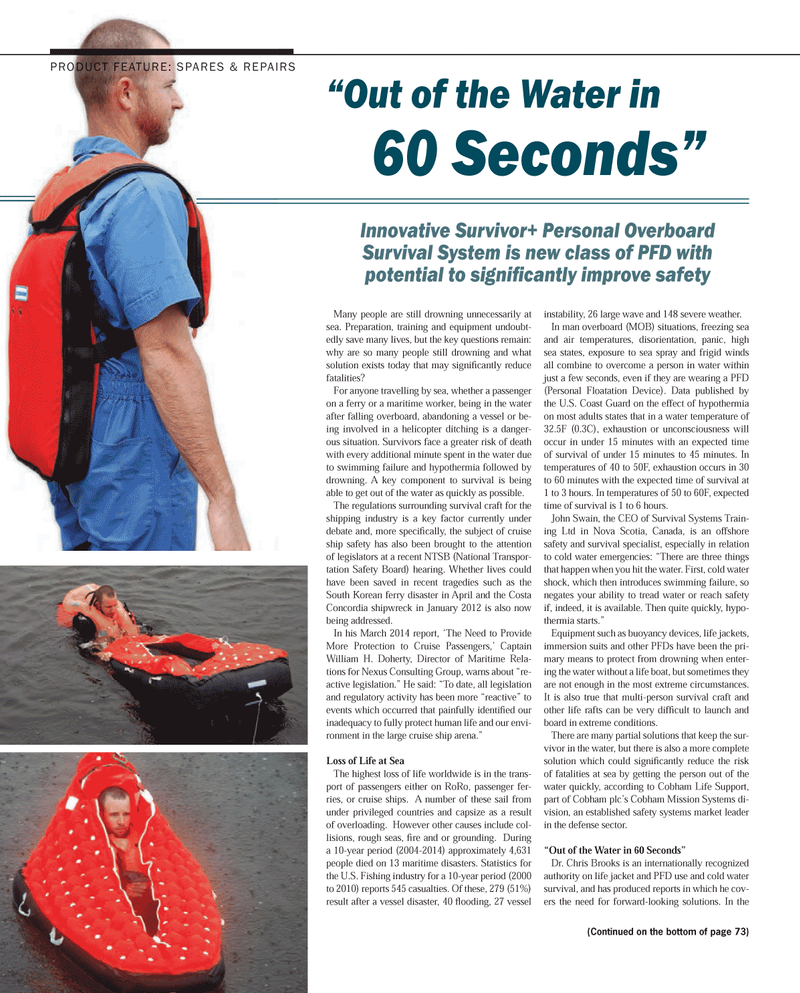
Page 70: of Maritime Reporter Magazine (June 2014)
Annual World Yearbook
Read this page in Pdf, Flash or Html5 edition of June 2014 Maritime Reporter Magazine
Many people are still drowning unnecessarily at sea. Preparation, training and equipment undoubt- edly save many lives, but the key questions remain: why are so many people still drowning and what solution exists today that may signi? cantly reduce fatalities?
For anyone travelling by sea, whether a passenger on a ferry or a maritime worker, being in the water after falling overboard, abandoning a vessel or be- ing involved in a helicopter ditching is a danger- ous situation. Survivors face a greater risk of death with every additional minute spent in the water due to swimming failure and hypothermia followed by drowning. A key component to survival is being able to get out of the water as quickly as possible.
The regulations surrounding survival craft for the shipping industry is a key factor currently under debate and, more speci? cally, the subject of cruise ship safety has also been brought to the attention of legislators at a recent NTSB (National Transpor- tation Safety Board) hearing. Whether lives could have been saved in recent tragedies such as the
South Korean ferry disaster in April and the Costa
Concordia shipwreck in January 2012 is also now being addressed.
In his March 2014 report, ‘The Need to Provide
More Protection to Cruise Passengers,’ Captain
William H. Doherty, Director of Maritime Rela- tions for Nexus Consulting Group, warns about “re- active legislation.” He said: “To date, all legislation and regulatory activity has been more “reactive” to events which occurred that painfully identi? ed our inadequacy to fully protect human life and our envi- ronment in the large cruise ship arena.”
Loss of Life at Sea
The highest loss of life worldwide is in the trans- port of passengers either on RoRo, passenger fer- ries, or cruise ships. A number of these sail from under privileged countries and capsize as a result of overloading. However other causes include col- lisions, rough seas, ? re and or grounding. During a 10-year period (2004-2014) approximately 4,631 people died on 13 maritime disasters. Statistics for the U.S. Fishing industry for a 10-year period (2000 to 2010) reports 545 casualties. Of these, 279 (51%) result after a vessel disaster, 40 ? ooding, 27 vessel instability, 26 large wave and 148 severe weather.
In man overboard (MOB) situations, freezing sea and air temperatures, disorientation, panic, high sea states, exposure to sea spray and frigid winds all combine to overcome a person in water within just a few seconds, even if they are wearing a PFD (Personal Floatation Device). Data published by the U.S. Coast Guard on the effect of hypothermia on most adults states that in a water temperature of 32.5F (0.3C), exhaustion or unconsciousness will occur in under 15 minutes with an expected time of survival of under 15 minutes to 45 minutes. In temperatures of 40 to 50F, exhaustion occurs in 30 to 60 minutes with the expected time of survival at 1 to 3 hours. In temperatures of 50 to 60F, expected time of survival is 1 to 6 hours.
John Swain, the CEO of Survival Systems Train- ing Ltd in Nova Scotia, Canada, is an offshore safety and survival specialist, especially in relation to cold water emergencies: “There are three things that happen when you hit the water. First, cold water shock, which then introduces swimming failure, so negates your ability to tread water or reach safety if, indeed, it is available. Then quite quickly, hypo- thermia starts.”
Equipment such as buoyancy devices, life jackets, immersion suits and other PFDs have been the pri- mary means to protect from drowning when enter- ing the water without a life boat, but sometimes they are not enough in the most extreme circumstances.
It is also true that multi-person survival craft and other life rafts can be very dif? cult to launch and board in extreme conditions.
There are many partial solutions that keep the sur- vivor in the water, but there is also a more complete solution which could signi? cantly reduce the risk of fatalities at sea by getting the person out of the water quickly, according to Cobham Life Support, part of Cobham plc’s Cobham Mission Systems di- vision, an established safety systems market leader in the defense sector. “Out of the Water in 60 Seconds”
Dr. Chris Brooks is an internationally recognized authority on life jacket and PFD use and cold water survival, and has produced reports in which he cov- ers the need for forward-looking solutions. In the “Out of the Water in 60 Seconds”
PRODUCT FEATURE: SPARES & REPAIRS (Continued on the bottom of page 73)
Innovative Survivor+ Personal Overboard
Survival System is new class of PFD with potential to signifi cantly improve safety
MR #6 (66-74).indd 70 6/9/2014 11:34:43 AM

 69
69

 71
71
